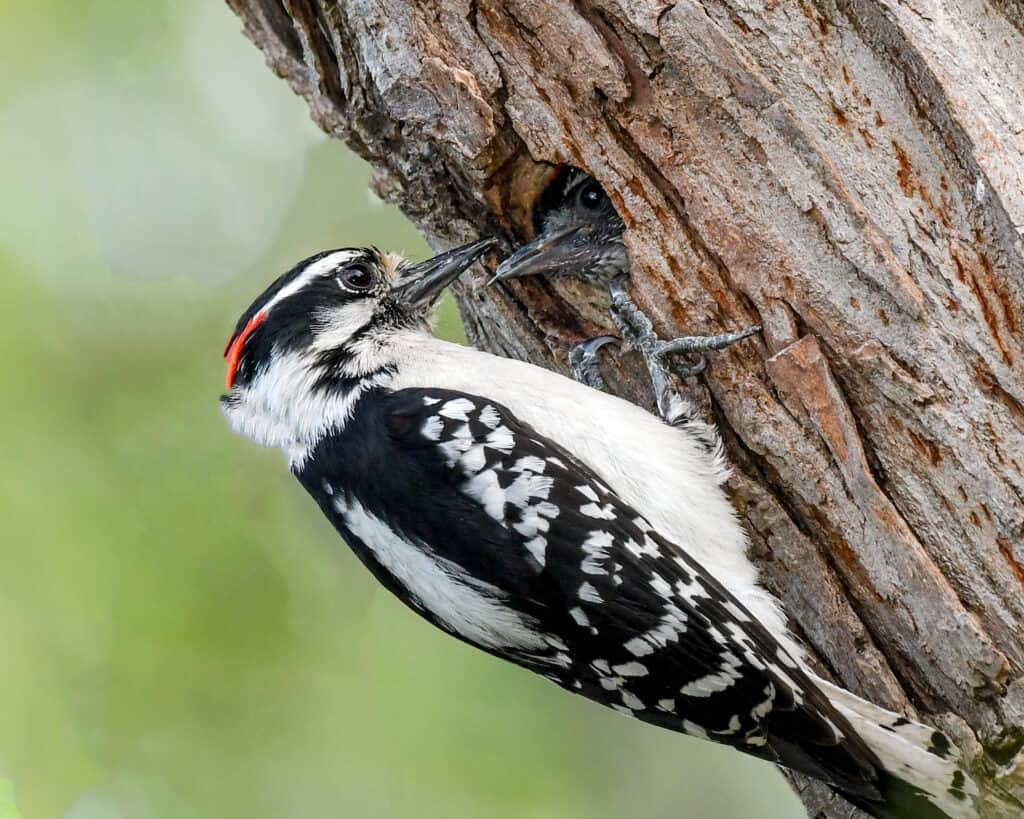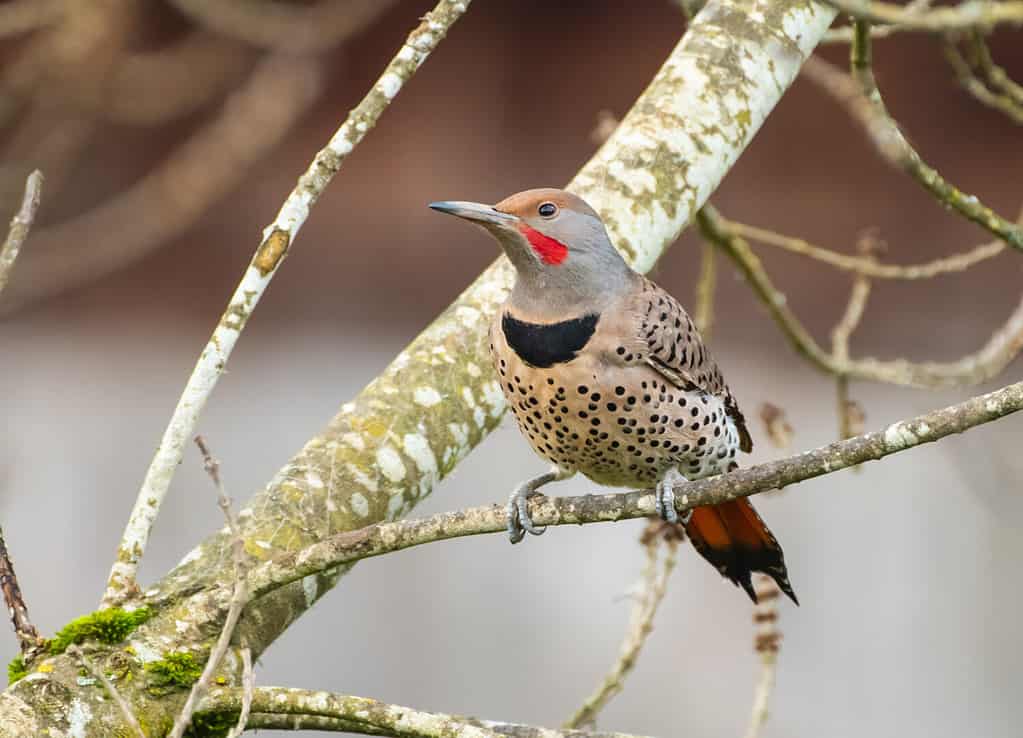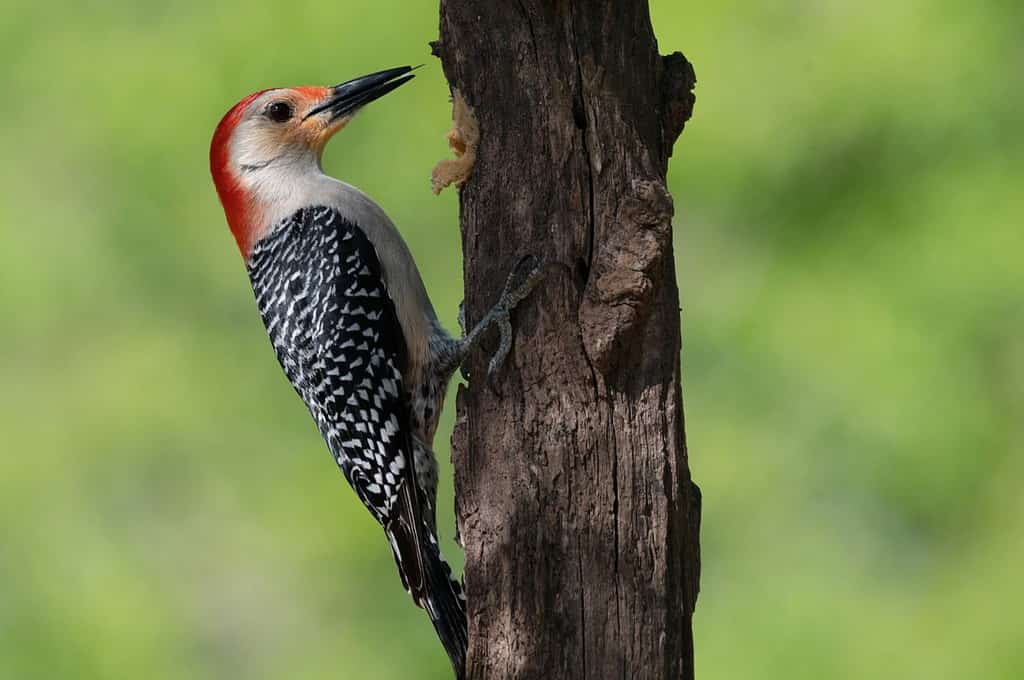Woodpeckers are a unique bird family that practically everyone can identify. However, most people cannot identify particular kinds of woodpeckers. In New Jersey, several types of species can be found. Woodpeckers in New Jersey range from very small downy woodpecker to pileated woodpecker, which is exceptionally big.
No matter what species it is, woodpeckers play a vital role in maintaining the health of forests and woodlands. Their pecking serves as a means of communication, and they help keep the pest population under control. While they can be harmful to trees, they are often more beneficial due to their control of the insect population.
1. Downy Woodpecker

Downy woodpeckers are exceptionally small.
©Brent Barnes/Shutterstock.com
The Downy woodpecker is the smallest woodpecker in New Jersey. They have a white belly, black wings with white spots, and a white face. You can identify them due to their distinctive black cap. Males also have a small red patch on the back of their heads, making them stand out more.
These woodpeckers are very adaptable, so they can be found almost anywhere. They prefer wooded habitats of all sorts, including gardens and forests. You may find them on tree trunks and branches, where they forage for insects.
2. Hairy Woodpecker

Hairy woodpeckers have white bellies with black backs, wings, and tail feathers.
©sandymsj/Shutterstock.com
The Hairy woodpecker is slightly larger than the Downy woodpecker. However, they have a similar black-and-white coloration, making them hard to distinguish. They have a somewhat longer bill that can make them easier to identify if you know what you’re looking for.
These woodpeckers prefer New Jersey’s mature forests and woodlands, though. They aren’t quite as adaptable. You’ll also find them on tree trunks and branches, where they will peck for insects.
3. Northern Flicker

Due to their unique markings, these birds are easy to identify among New Jersey woodpecker species.
©Jennifer Bosvert/Shutterstock.com
Northern Flickers are distinctive thanks to their brownish-gray plumage. They have a predominant black crescent on their chest and a unique white rump patch. Thanks to these markings, they’re pretty easy to tell apart from other species. Males also have a red patch on their head.
This is another adaptable species. They can be found in many habitats, including fields, woodlands, and suburban areas. However, unlike most other species, they feed on ants on the ground. Therefore, they will likely be on the ground instead of on tree trunks.
4. Red-bellied Woodpecker

Despite their name, these birds do
nothave a red belly.
©Connie Moore/Shutterstock.com
Despite the name, the Red-bellied Woodpecker has a red crown on its head rather than its belly. They have a zebra-like black-and-white back pattern and a pale, slightly reddish belly. They look different enough from other species that you can tell them apart.
They prefer to inhabit woodlands, parks, and suburban areas. They need trees to thrive, just like other woodpeckers. Therefore, you’ll often find this species wherever trees are found.
They eat insects from trees, like most other woodpecker species.
5. Pileated Woodpecker

These woodpeckers are absolutely
massive, making them easy to identify.
©MasterShopArt/Shutterstock.com
The Pileated woodpecker is an extremely large species that looks rather striking. They have black bodies with white stripes on their neck. Their red crests are also very distinctive, so you’ll likely notice them in the trees.
Because they are larger, they also need larger trees. They prefer mature forests and wooded areas that have been around for a while. They tend to spend most of their time high up in the trees, creating large holes while foraging for insects.
6. Yellow-bellied Sapsucker

While these birds consume sap, they also eat insects and seeds.
©Christopher Unsworth/Shutterstock.com
Yellow-bellied Sapsuckers are easily recognized by their black and white markings and the yellow wash on their bellies. They also have a red crown and a prominent white stripe on their wings.
Unlike other species, they drill holes in the bark to feed on the sap underneath. Therefore, they require trees that produce plenty of sap, such as maple trees. They’re usually found in mixed woodlands, though they can live just about anywhere that has sap-producing trees.
Common Locations
This state has a diverse landscape with a rich tapestry of habitats where woodpeckers thrive. There are often plenty of areas in the state where these birds thrive. Therefore, you should have the chance to see one no matter where in the state you live.
New Jersey boasts an abundance of woodlands and forests, where most of these birds prefer to live. However, the woodlands are particularly dense in the northern and western regions, so you’re most likely to find woodpeckers in this area.
In woodlands, you’re most likely to find woodpeckers in New Jersey on tree trunks and branches. Most forage for insects on tree trunks.
Parks and reserves, such as Maurice River Bluffs Preserve, are a particularly common place to find these birds. They offer a protected space for both birds and birdwatchers. Therefore, they can be a great place for birdwatching enthusiasts.
Summary of 6 Woodpeckers in New Jersey
| Number | Species |
|---|---|
| 1 | Downy Woodpecker |
| 2 | Hairy Woodpecker |
| 3 | Northern Flicker |
| 4 | Red-bellied Woodpecker |
| 5 | Pileated Woodpecker |
| 6 | Yellow-bellied Sapsucker |
The photo featured at the top of this post is © Wirestock/iStock via Getty Images
Thank you for reading! Have some feedback for us? Contact the AZ Animals editorial team.







